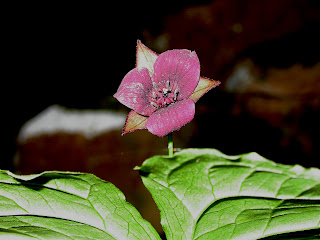Trillium catesbaei, a true Trillium (in the subgenus Trillium), was to me the most graceful Trillium of the trip. We found it growing in moist acidic woods, as well as in the grassy, somewhat shrubby area near our campsite at DeSoto State Park in Alabama. As the name implies, this trillium was named in honor of English naturalist Mark Catesby. This is one of the trillies with a pedicel that nods, leading to flowers held below the bracts. According to Case and Case, there is a form of this species that grows in South Carolina with an erect pedicel. The stigmas, unlike those of the somewhat similar Trillium cernuum and Trillium flexipes, are uniformly thin throughout, although they are connected basally into a short style. The petals are curved backwards and range in color from white to pink.
Trillium cuneatum is an extremely variable species, with petal color ranging from maroon to purple to brown to green to yellow, and to all colors in between. Petals are sometimes even bicolored. We saw most of these color variants at Old Stone Fort State Park in Tennessee and at Cloudland Canyon State Park in Georgia. The specific epithet comes from the shape of the petals, which are wedge-shaped at the base and broad above. This trillium was observed in upland woods; it is known to occur in both sandstone- and limestone-based soils. Unlike the species above and below, the flowers of Trillium cuneatum are sessile. This is one big trillie, growing to up to 45 cm tall, with petals sometimes longer than 6 cm. The stigmas of this species are separate to the base, putting it in the subgenus Phyllantherum. Unlike Trillium recurvatum, the sepals are horizontally spreading to erect. Trillium cuneatum may be confused with Trillium sessile, but the anther dehiscense is latrorse in the former and introrse in the latter. Finally, the connectives of the stamens of Trillium cuneatum are barely prolonged beyond the anthers, and the leaves come to an abrupt point.

Trillium sulcatum was the least common of the three trilliums that we observed. We found it only in a couple of spots in acidic, mesic forest at Cloudland Canyon State Park in Georgia, where it is at the edge of its range. Like Trillium catesbaei, Trillium sulcatum is in the subgenus Trillium; however, the flowers are on pedicels held above the bracts. The specific epithet comes from the boat-shaped tips of the sepals. The stigmas are thickened basally, and the ovaries are large and six-angled. Trillium sulcatum has petals that are wider than the sepals, and leaves that are very wide. This species is similar to Trillium erectum, and has been treated as a variety of T. erectum by some authors; however, according to Case and Case, Trillium sulcatum generally is taller, larger-leaved, and more robust than Trillium erectum. Also, the flowers of Trillium sulcatum face outward at a 90 degree angle from the erect pedicel, a feature not seen in Trillium erectum.



4 comments:
Wow that Trillium catesbaei is sweet! Very informative post and nice pictures, Scott. I see you're kneeling in a thicket of your second-most-favorite plant, Rhus radicans! I hope you got to see a lot of Rhus vernix, as well. Did you rush right out to the woods after play practice that day?
No Rhus vernix, unfortunately. And that is not a costume... that's my new botanical garb.
We had a Trillium Fest in Ohio- but the species you recorded on the "tromp" were sweet!
And, I like the suit! After all, botany was considered the cultured gentleman's pursuit.
Weedpicker Cheryl
Thanks Cheryl. Glad you enjoyed our Trillium Tromp highlights. There is a great diversity in the genus Trillium, and most of the species have very limited geographical ranges. I hope to see many more in future tromps...
... and I will be sure to wear my botanical uniform and carry my vasculum!
Post a Comment